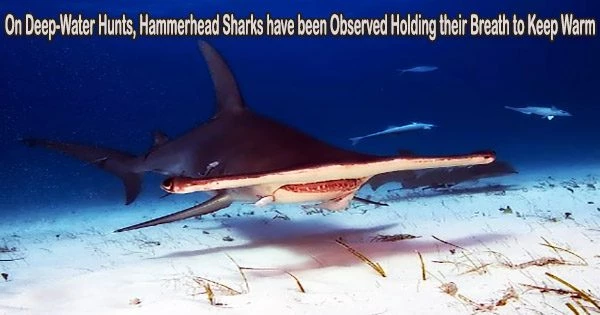The hammerhead shark is a unique and distinctive species of shark known for its unusual head shape, which resembles a hammer or T-shaped structure. While deep diving into chilly water to hunt prey like deep sea squids, scalloped hammerhead sharks hold their breath to keep their bodies warm.
This discovery, published in Science by University of Hawai’i at Mānoa researchers, provides important new insights into the physiology and ecology of a species that serves as an important link between the deep and shallow water habitats.
“This was a complete surprise,” said Mark Royer, lead author and researcher with the Shark Research Group at the Hawai’i Institute of Marine Biology (HIMB) in the UH Mānoa School of Ocean and Earth Science and Technology. “It was unexpected for sharks to hold their breath to hunt like a diving marine mammal. It is an extraordinary behavior from an incredible animal.”
Shark gills are natural radiators that, if scalloped hammerhead sharks did not seal their gill slits during deep dives into cold water, would quickly cool the blood, muscles, and organs. These sharks are warm water animals but feed at depths where seawater temperatures are similar to those found in Kodiak Alaska (around 5ºC/ 40ºF), yet they need to keep their bodies warm in order to hunt effectively.
“Although it is obvious that air-breathing marine mammals hold their breath while diving, we did not expect to see sharks exhibiting similar behavior,” said Royer. “This previously unobserved behavior reveals that scalloped hammerhead sharks have feeding strategies that are broadly similar to those of some marine mammals, like pilot whales. Both have evolved to exploit deep dwelling prey and do so by holding their breath to access these physically challenging environments for short periods.”
By giving deep-diving scalloped hammerhead sharks instruments that simultaneously assessed their muscle temperature, depth, body orientation, and activity levels, the research team was able to unearth this surprising phenomena.
This was a complete surprise. It was unexpected for sharks to hold their breath to hunt like a diving marine mammal. It is an extraordinary behavior from an incredible animal.
Mark Royer
When the sharks surfaced toward the conclusion of each dive, they observed that their muscles had remained warm throughout the whole plunge into the chilly depths. In order to keep their bodies warm during these deep dives into frigid water, hammerhead sharks may be reducing heat loss from their gills, according to computer models.
Additionally, video of a scalloped hammerhead shark swimming along the seabed at a depth of 1,044 meters (more than 3,400 feet) showed its gill slits tightly closed, whereas similar images from surface waters show these sharks swimming with their gill slits wide open.
When scalloped hammerhead sharks surface at the end of each dive, there is a sudden drop in muscle temperature, which suggests that they opened their gill slits to resume breathing while still in relatively cool water.
“Holding their breath keeps scalloped hammerhead sharks warm but also shuts off their oxygen supply,” said Royer. “So, although these sharks hold their breath for an average of 17 minutes, they only spend an average of four minutes at the bottom of their dives at extreme depths before quickly returning to warmer, well-oxygenated surface waters where breathing resumes.”
“This discovery fundamentally advances our understanding of how scalloped hammerhead sharks are able to dive to great depths and withstand frigid temperatures in order to capture prey,” said Royer. “It also demonstrates the delicate physiological balance that scalloped hammerhead sharks must strike in order to forage successfully.”
Scalloped hammerhead sharks are not listed as threatened in Hawaiʻi but are regionally endangered in other parts of the world due to overfishing, bycatch, and nursery habitat loss.
“This new and detailed understanding of scalloped hammerhead physiology and ecology enhances our ability to effectively manage and conserve this iconic species by revealing potential vulnerabilities associated with changing ocean conditions or future human exploitation of these deep foraging habitats, such as deep-sea mining or large-scale fishing in the mesopelagic ‘twilight zone’, both of which might make it harder or more dangerous for these sharks to hunt their natural prey,” said Royer.
“This extraordinary physiological feat that allows scalloped hammerhead sharks to expand their ecological niche into the deep sea could very well make them vulnerable to additional human impacts.”
















